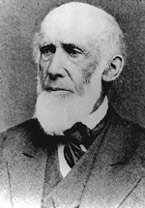Railways  |
| A "Jervis" 4-2-0 |
text
text
text
text
 |
Jervis in old age
(Public domain) |
John Bloomfield Jervis (1795–1885) was an American engineer who built railways, canals and water supply systems in the United States. He designed the first locomotive to run there.
Jervis worked on numerous projects, notably the Croton Aqueduct, which supplied water to New York, and he was also involved with several railroads. From 1831 he was the chief engineer of the Mohawk and Hudson Railroad and it was while working in this post that he came up with the innovation for which he is particularly known, the 4-2-0 locomotive with a leading bogie. The bogie, a four-wheeled truck which swivelled, guided the locomotive more effectively round curves. Previously, locomotives in the U.S.A. had been of the 0-4-0 configuration, while in England some 4-2-0s were built, but they had rigid frames with two separate axles at the front.  |
The original Jervis 4-2-0
(Public domain) |
The photo on the left shows Jervis's own drawing of the locomotive he proposed. The leading bogie is clearly seen. This design proved successful and the configuration was used for many years. For example, the locomotive in the logo of this subsection is from the end of the nineteenth century or the beginning of the twentieth. The Hackensack and New York Railroad ran from Rutherford, New Jersey to Hackensack, New Jersey and service started in 1858, but the photo was taken in the early 1900s. Hackensack is just 12 miles from Midtown Manhattan and no doubt the railway made it a suitable place from which to commute.
Jervis had a long and successful career and there is a more detailed account of his life in the Wikipedia article. He was commemorated in the name of a locomotive  |
High-pressure locomotive John B. Jervis
(Public domain) |
built for the Delaware and Hudson Railway in 1927. An unusal feature of this loco is a 2-axle booster at the rear of the tender, evidence of which can be seen in the photo on the left. According to the Wikipedia article on them, booster engines are connected to the trailing truck axle on the locomotive or, if none, the lead truck on the tender. The purpose is to provide additional traction when starting a heavy train and to maintain slow speed under demanding conditions. I am not too sure why it would be good idea to put such a booster on the trailing truck of the tender, at a greater distance from the source of steam, but maybe it has something to do with the weight borne by that truck. A greater weight would give better adhesion and thus provide more effective traction.[Note]
Jervis is also commemorated in the name of Port Jervis on the Delaware and Hudson Canal and in the name of the Jervis Public Library, located in his home at Rome, New York.
Note - Or so thinks this layman!